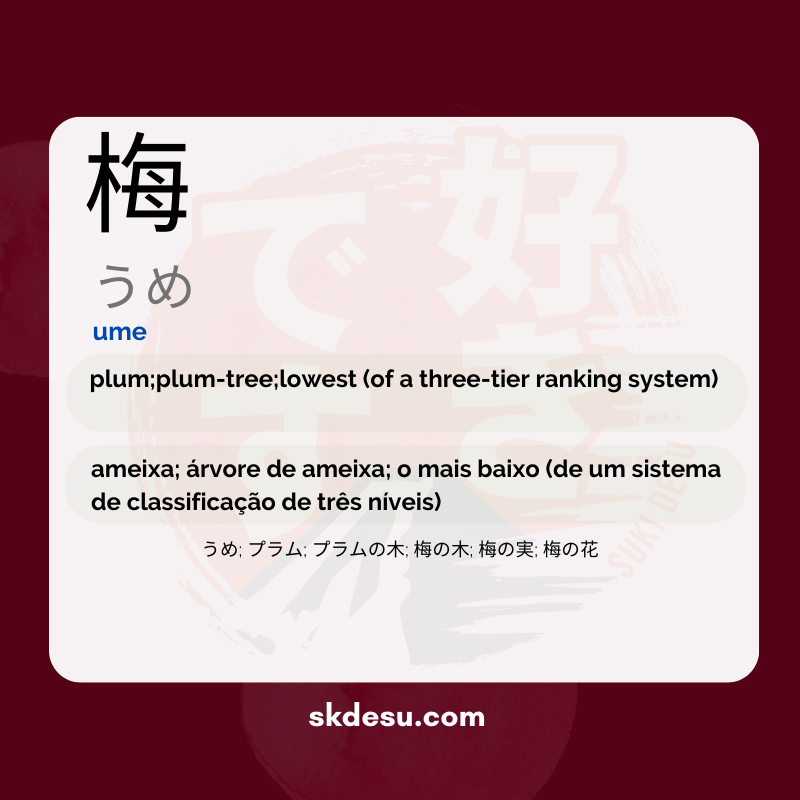Translation and Meaning of: 梅 - ume
On this page, we will study the meaning of the Japanese word 梅 (ume) and its translation into English. Let's see their different meanings, example phrases, explanations, etymology and the similar words.
Romaji: ume
Kana: うめ
Type: noun
L: jlpt-n3
Translation / Meaning: plum; plum tree; the lowest (of a three -level classification system)
Meaning in English: plum;plum-tree;lowest (of a three-tier ranking system)
Definition: Plum: Fruit tree belonging to the Rosaceae family, the fruit is used in the making of preserved plums and plum wine.
Sumário
- Etymology
- Vocabulary
- Writing
- Phrases
Explanation and Etymology - (梅) ume
Etymology and Meaning of 梅 (ume)
The Japanese word 梅 (ume) refers to the Japanese plum, a remarkable fruit in both cultural and culinary terms in Japan. The kanji 「梅」 has Chinese origins, representing not only the fruit but also the tree and its flowers. In the Japanese context, the kunyomi reading "うめ" (ume) is more common. The ume plum is celebrated for its specific sweet and sour flavor and its cultural significance.
Origin and History of 梅 (ume)
The Japanese plum trees, which give rise to ume, have a fascinating history in Japan. They were introduced from China during the Nara period (710-794). Since then, ume has become emblematic in Japanese gardens and is often associated with the arrival of spring. The blooming of umeboshi, plum blossoms, precedes that of sakura cherry blossoms, providing a beautiful transition between winter and spring.
Cultural and Culinary Uses of 梅 (ume)
The uses of ume in Japan are diverse and encompass both culinary and cultural aspects. In cuisine, the plum is very popular in the form of umeboshi, which are pickled plums known for their distinctly sour and salty flavor. Additionally, the plum is a key ingredient in the preparation of the delicious liqueur known as umeshu. Culturally, ume flowers symbolize perseverance and hope, often depicted in Japanese art and poetry. The celebration of Hanami, which is the contemplation of flowers, often includes flowering plum trees along with cherry blossoms.
Synonyms and similar words
- 梅 (Ume) - Plum (a fruit and the plant)
- プラム (Puramu) - Plum (term in katakana, usually refers to western versions)
- プラムの木 (Puramu no ki) - Plum tree
- 梅の木 (Ume no ki) - Japanese apricot tree (referring specifically to the Japanese ume)
- 梅の実 (Ume no mi) - Ume fruits (specifically the fruits of the ume plant)
- 梅の花 (Ume no hana) - Ume flowers (referring to the flowers of the ume plant)
Words related
Words with the same pronunciation: うめ ume
How to Write in Japanese - (梅) ume
See below a step-by-step guide on how to write the word by hand in Japanese (梅) ume:
Example Sentences - (梅) ume
Below are some example sentences:
Umeboshi wa Nihon no dentōteki na hozon shokuhin desu
Umeboshi is a traditional preserved Japanese food.
- 梅干 - umeboshi, a Japanese pickled plum
- は - topic particle
- 日本 - Japan
- の - possession particle
- 伝統的な - traditional
- 保存食品 - preserved food
- です - verb "to be" in polite form
Other words of the same type: noun
See other words from our dictionary that are also: noun

